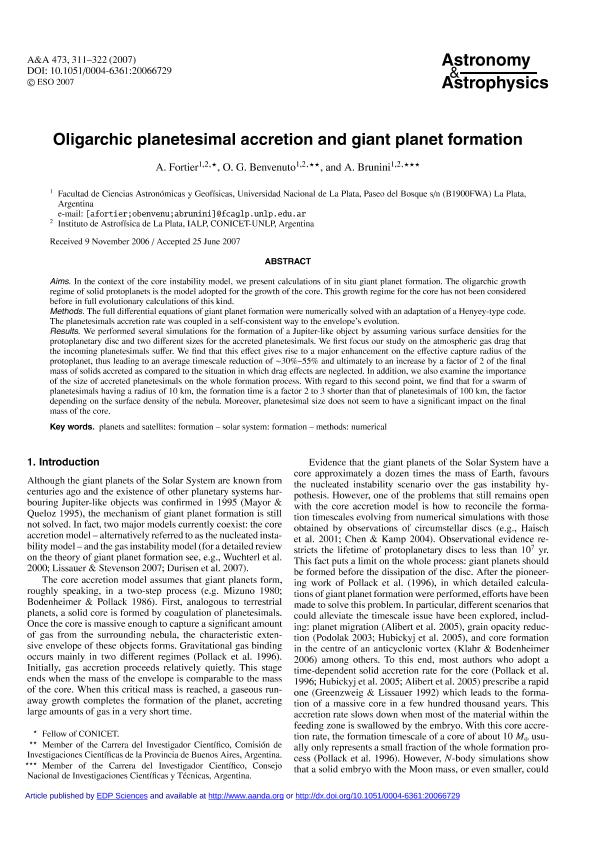Mostrar el registro sencillo del ítem
dc.contributor.author
Fortier, Andrea

dc.contributor.author
Benvenuto, Omar Gustavo

dc.contributor.author
Brunini, Adrian

dc.date.available
2018-04-16T14:17:42Z
dc.date.issued
2007-12
dc.identifier.citation
Fortier, Andrea; Benvenuto, Omar Gustavo; Brunini, Adrian; Oligarchic planetesimal accretion and giant planet formation; EDP Sciences; Astronomy and Astrophysics; 473; 1; 12-2007; 311-322
dc.identifier.issn
0004-6361
dc.identifier.uri
http://hdl.handle.net/11336/42103
dc.description.abstract
Aims. In the context of the core instability model, we present calculations of in situ giant planet formation. The oligarchic growth regime of solid protoplanets is the model adopted for the growth of the core. This growth regime for the core has not been considered before in full evolutionary calculations of this kind. Methods. The full differential equations of giant planet formation were numerically solved with an adaptation of a Henyey-type code. The planetesimals accretion rate was coupled in a self-consistent way to the envelope’s evolution. Results. We performed several simulations for the formation of a Jupiter-like object by assuming various surface densities for the protoplanetary disc and two different sizes for the accreted planetesimals. We first focus our study on the atmospheric gas drag that the incoming planetesimals suffer. We find that this effect gives rise to a major enhancement on the effective capture radius of the protoplanet, thus leading to an average timescale reduction of ∼30%–55% and ultimately to an increase by a factor of 2 of the final mass of solids accreted as compared to the situation in which drag effects are neglected. In addition, we also examine the importance of the size of accreted planetesimals on the whole formation process. With regard to this second point, we find that for a swarm of planetesimals having a radius of 10 km, the formation time is a factor 2 to 3 shorter than that of planetesimals of 100 km, the factor depending on the surface density of the nebula. Moreover, planetesimal size does not seem to have a significant impact on the final mass of the core.
dc.format
application/pdf
dc.language.iso
eng
dc.publisher
EDP Sciences

dc.rights
info:eu-repo/semantics/openAccess
dc.rights.uri
https://creativecommons.org/licenses/by-nc-sa/2.5/ar/
dc.subject
Solar System
dc.subject
Giant Planets
dc.subject
Origins of Planets
dc.subject
Numerical Methods
dc.subject
Satellites
dc.subject
Planets
dc.subject.classification
Astronomía

dc.subject.classification
Ciencias Físicas

dc.subject.classification
CIENCIAS NATURALES Y EXACTAS

dc.title
Oligarchic planetesimal accretion and giant planet formation
dc.type
info:eu-repo/semantics/article
dc.type
info:ar-repo/semantics/artículo
dc.type
info:eu-repo/semantics/publishedVersion
dc.date.updated
2018-04-09T16:57:01Z
dc.journal.volume
473
dc.journal.number
1
dc.journal.pagination
311-322
dc.journal.pais
Francia

dc.journal.ciudad
Les Ulis
dc.description.fil
Fil: Fortier, Andrea. Universidad Nacional de La Plata. Facultad de Ciencias Astronómicas y Geofísicas; Argentina. Consejo Nacional de Investigaciones Científicas y Técnicas. Centro Científico Tecnológico Conicet - La Plata. Instituto de Astrofísica La Plata. Universidad Nacional de La Plata. Facultad de Ciencias Astronómicas y Geofísicas. Instituto de Astrofísica La Plata; Argentina
dc.description.fil
Fil: Benvenuto, Omar Gustavo. Universidad Nacional de La Plata. Facultad de Ciencias Astronómicas y Geofísicas; Argentina. Consejo Nacional de Investigaciones Científicas y Técnicas. Centro Científico Tecnológico Conicet - La Plata. Instituto de Astrofísica La Plata. Universidad Nacional de La Plata. Facultad de Ciencias Astronómicas y Geofísicas. Instituto de Astrofísica La Plata; Argentina
dc.description.fil
Fil: Brunini, Adrian. Universidad Nacional de La Plata. Facultad de Ciencias Astronómicas y Geofísicas; Argentina. Consejo Nacional de Investigaciones Científicas y Técnicas. Centro Científico Tecnológico Conicet - La Plata. Instituto de Astrofísica La Plata. Universidad Nacional de La Plata. Facultad de Ciencias Astronómicas y Geofísicas. Instituto de Astrofísica La Plata; Argentina
dc.journal.title
Astronomy and Astrophysics

dc.relation.alternativeid
info:eu-repo/semantics/altIdentifier/doi/http://dx.doi.org/10.1051/0004-6361:20066729
dc.relation.alternativeid
info:eu-repo/semantics/altIdentifier/url/https://www.aanda.org/articles/aa/abs/2007/37/aa6729-06/aa6729-06.html
Archivos asociados
